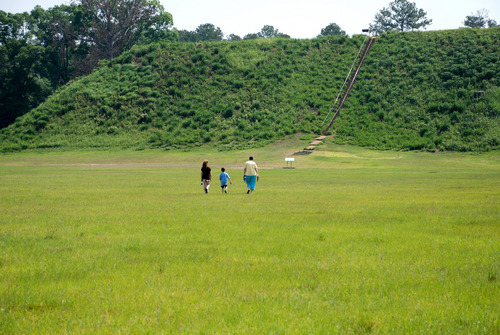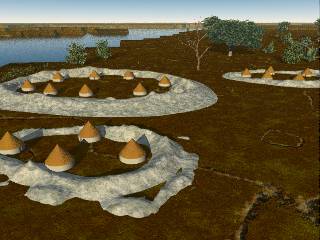Ancient Native American Sites in Georgia | Part 5: Kolomoki Mounds
 Kolomoki Mounds in Blakely, Georgia represents the beginnings of a new type of architecture for Georgia’s Indians: pyramids. Kolomoki’s massive Temple Mound is an earthen pyramid over 57 feet tall and its base is larger than a football field. It was constructed from colored clays primarily red and white clay with steps leading to the top where possible structures such as temples or a chief’s residence were located.
Kolomoki Mounds in Blakely, Georgia represents the beginnings of a new type of architecture for Georgia’s Indians: pyramids. Kolomoki’s massive Temple Mound is an earthen pyramid over 57 feet tall and its base is larger than a football field. It was constructed from colored clays primarily red and white clay with steps leading to the top where possible structures such as temples or a chief’s residence were located.
Kolomoki was the largest Native American settlement north of Mexico during its time period. Constructed over 1500 years ago between the years 300-750 AD, the inhabitants of Kolomoki were a sophisticated people. They maintained trade contacts with other groups all over eastern North America. They produced some of the most unique pottery in all of the southeast. The pottery, called sacred Weeden Island pottery, includes pots thought to be used as calendars as well as star maps of the night sky.
When the funeral mound was excavated at Kolomoki, numerous pots in the shapes of various animals were uncovered along with the skeletal remains of multiple individuals. It is thought that the Chief’s servants were sacrificed and buried with him at the time of his death so that they could continue to serve him in the after-life. The on-site museum houses a display of this pottery as well as a reenactment of the burial ceremony.
The residents of Kolomoki were farmers who grew corn as well as hunted wild game and gathered wild foods from the surrounding forests. Corn is a native plant of Mexico and evidence continues to mount suggesting a migration of people from Mexico into the southeast. The migration legends of several tribes indicate such a migration or multiple migrations. In fact, the migration legend of the Hitchiti Indians who dominated most of Georgia during this time period suggests they arrived in the Lake Okeechobee region of south Florida by boat and migrated north into Georgia. The earliest evidence of corn agriculture in the southeast is actually found in the Lake Okeechobee area.
Interestingly, Florida’s Miccosukee tribe is the last remnant of Hitchiti-speaking Indians in the southeast and many words in their language appear to have a Mayan origin. It may very well be the case that the Miccosukee’s ancestors migrated from Mexico’s Yucatan region and arrived in Florida eventually building such places as Kolomoki Mounds as they moved northward into Georgia.
In fact, the Miccosukee were originally known as the lower Chiaha. Chiaha is a Mayan word meaning “edge water” or “water’s edge” which is exactly where the Miccosukee built their villages, along the banks of rivers and lakes. The Miccosukee word for house is “chiki” which is identical to the Totonac word for house. The Totonacs were neighbors to the Maya in Mexico and adopted the Mayan word “chiki” which means “woven basket” to describe their homes which were made from woven mats.
It is also possible that their ancestors were escaped slaves from Mexico. Mayan slaves wore turbans which is the same headdress that southeastern tribes wore when first encountered by Europeans. This might also explain why the pyramids they built such as at Kolomoki were not faced with stone. Certainly it was slave labor that did the bulk of the work in building Mexico’s pyramids but it would have been skilled craftsman who carved the stone facings for these structures. Thus when the slaves fled for Florida they brought with them the ability to build pyramids but lacked the ability to face them with stone. This would also explain the general lack of Mexican artifacts found in archaeological digs in the southeast. Slaves would not have owned anything to bring with them except for some grains of corn to plant once they arrived.
Even today desperate people make the journey from Haiti and Cuba to Florida on flimsy, make-shift rafts to escape their miserable conditions back home. Perhaps Florida’s history has always been one of refugees arriving from other lands looking for a better life.
Kolomoki Mounds State Park is approximately five hours southwest of Savannah and includes a campground and museum along with the pyramid mounds which you can climb. Be sure to watch the short video clip included in this article and subscribe to my articles using the “subscribe” link below my name to be kept updated on the next installment in this series.
For More Info
- Read my Kolomoki Mounds article @ LostWorlds.org
- Buy my “Lost Worlds: Georgia” DVD



